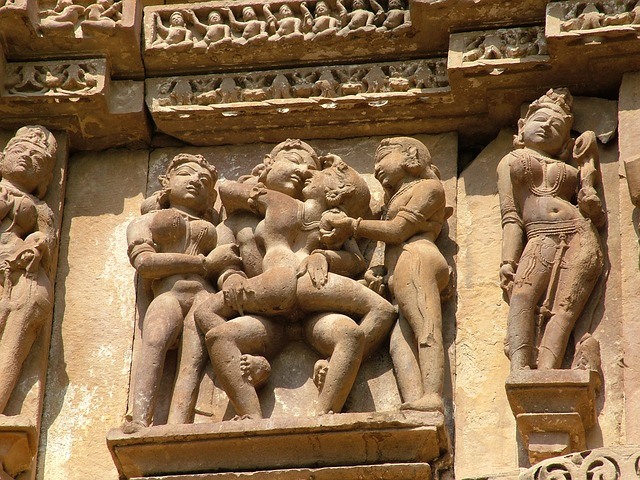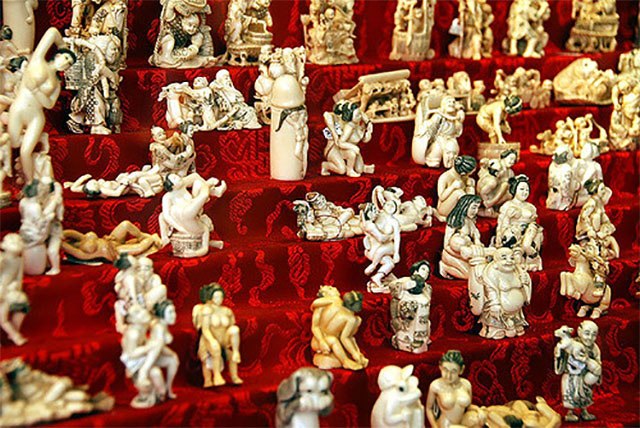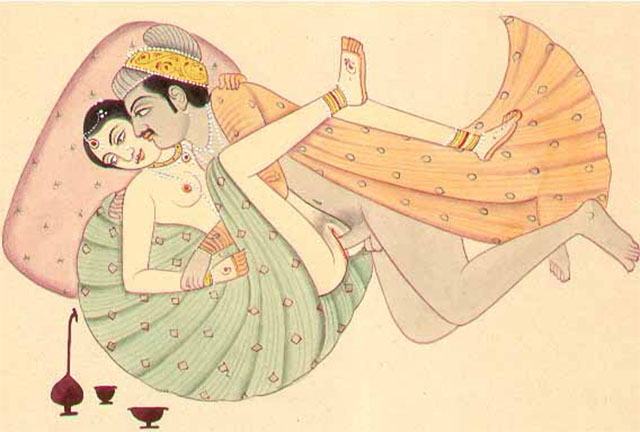Think you know what the Kama Sutra is really about?
Often thought to be just a manual on sex positions, the original text extends to cover more than just contortionism in the bedroom. The Kama Sutra is a famously misunderstood piece of literature that actually focuses more on love, marriage and spirituality than the various ways to you can manoeuvre your partner for sexual pleasure.
In this feature, we take a closer look at the Kama Sutra and find out more about the origins of the text, what it’s really all about and why it remains such a popular book in the modern age.
What is the Kama Sutra?
Credited as being the work of the ancient Indian philosopher, Vatsyayana, the Kama Sutra is one of the most famous books in the world; certainly, the most famous book ever written about human sexuality.

There have many translations and variations of the book in the last forty years, including manuals, DVDs and novelty games all focusing on one part of the Kama Sutra; the various ways to couple during sex.
It is believed that the Indra Sinha translation which was published in 1980 was the first widely distributed copy and it is this text that is often reproduced, particularly on the internet.
The words, ‘Kama’ and ‘Sutra’ are both Sanskrit and can loosely be translated as follows:
- Kama, meaning pleasure or desire.
- Sutra , meaning rules or principles of truth.
The exact date that the text was written is unclear and there is a lot of debate among scholars about this but is believed to be somewhere between 400 BC and 300 AD.
It is a commonly held belief that the Kama Sutra is simply a manual demonstrating various sexual positions. However, this is far from the truth about this important guide and the Kama Sutra is just as much a text on emotional and spiritual satisfaction as it is an instructional guide for physical lovemaking.
The Kama Sutra is predominantly written about the philosophy of love and includes chapters on:
- Desire and what triggers it, sustains it and what are both good and bad desires;
- The art of being socially engaging
- How to find a partner
- Flirting
- Maintaining a fulfilling marriage
- How, and when, to commit adultery
And, of course, there is a detailed guide (with accompanying diagrams, photos or illustrations) in modern translations) of the various sexual positions.

The Goal of the Kama Sutra
The Kama Sutra can be summed up as an instructional guide to fulfilling a happy sex life for both you and your partner in a spiritual, emotional and physical way.
It does this in accordance with the ancient Hindu traditions of Dharma, Artha, Kama and Moksha.
Known as the ‘four goals of life’, these concepts (known as the purusharthas) are a part of the Hindu belief that the soul has a purpose and that every deed we do and thought we have are influenced by one of these universal aims:
- Dharma – righteousness, ethics and duty
- Artha – economic values, wealth and prosperity
- Kama – psychological values, sensual pleasures, gratification, love and hedonism
- Moksha – spiritual values and liberation
The Kama Sutra can therefore be seen as a way of guiding us in the pursuit of happiness….by way of pleasure.
The Influence of the Kama Sutra
It is surprising that a book that was written over two thousand years ago is still in print today and enjoys such an enormous contemporary following. As well as being available in multiple languages, the Kama Sutra has been widely translated and there are thousands of variants; from those that focus solely on the sexual positions with illustrations or photographs to faithful modern translations taken from ancient Sanskrit, Hindi and Bengali.

So, why has the popularity of the Kama Sutra endured through the ages and what is its relevance to modern life?
To understand this question, we need to look more closely at what the book can teach us…other than how to perform seemingly impossible sexual positions!
Contents of the Kama Sutra
The original Kama Sutra was written in seven books covering 36 chapters in 64 sections and presented in 1,250 verses.
Although the modern version of the text now includes 67 sections, the contents of the Kama Sutra remain broadly the same as they were originally written.
Book 1: Introduction
There are five chapters in the first book of the Kama Sutra which cover the history of Kama and a detailed outline of the interrelationship of three of the four goals of life; Kama, Artha and Dharma.
The first book has a detailed list and definition of the 64 arts that (apparently) make a woman more cultivated and, thus, more attractive. These arts include singing, dancing and cooking (with us so far?) as well as some more culturally and period specific instructions such as turban tying, adorning idols with flowers and the art of making ear ornaments.
It is also suggested that the ability to impersonate, solve riddles and producing music by striking glasses filled with water are also essential.
This part of the Kama Sutra also goes on to outline the ways an urban or rural gentleman can improve his Kama through work, entertainment, socialization and drinking parties. There is also some advice on what not to do in the pursuit of Kama.
There is also a section included in Book 1 on daily life which includes how to arrange your household furniture.
The final chapter of the first book is where you can find information on the various classes of women; namely women who have been twice married, public women (prostitutes) and maids, There is quite some detail about which women you should avoid including lepers, lunatics and near relations (good advice) plus some helpful hints on:
- How to find a sexual partner.
- How to be faithful.
- How and when to commit adultery.
This book also has some detailed information on sex but the best is yet to come…
Book 2: Sexual Union
Now we come to the good part and the part of the book for which the Kama Sutra has earned its reputation; sex.
Book 2 has many verses and covers a whole range of interesting information on almost every aspect of sex from foreplay and types of lover to duration of sex, positions and types of climax.
Men are divided into three classes of lover according to their ‘size’, namely Hare, Bull and Horse. Women, too, are categorized as being either a Deer, Mare of Elephant according to the depth of their ‘yoni’. There is some interesting reading here about how unions must be equal and the importance of the ‘dimensions’ between two lovers.

In total, this second book has ten chapters, each focusing on a very specific area with verses covering detailed information, including:
- The kinds of sexual union and love with emphasis on the uniqueness of every lover you have. There are some general guidelines here on foreplay, endurance, intimacy, duration of sex and even the temperament of different types of lovers.
- Embracing, massaging and touching each other; the prelude to foreplay including conversations and how to figure out if someone is interest in having sex.
- How to kiss plus some very pertinent advice on personal hygiene.
- Impact play; here you can find information on other forms of physical intimacy that doesn’t relate specifically to sex including biting, scratching, slapping and cuddling. BDSM fans will enjoy the chapter on the various ways of striking a partner including the sounds that these different actions make.
- Oral sex for both men and women and methods for ‘holding the lingam (penis) in the mouth.
- Experimenting with your partner and the benefits of surprising each other with variations on lovemaking.
- Communication before, during and after intercourse including the subject of ‘moaning’. There is also some information about quarreling and how to revive passion when it gets dull.
There is also some interesting customs and practices that are outlined in this chapter which make for some ‘enlightening’ reading.
And, of course, there is detailed descriptions and, in modern texts, accompanying diagrams, illustrations or photos of the various sexual positions that can be achieved.
Positions of the Kama Sutra
The original text of the Kama Sutra merely describes a variety of sexual positions and ascribes them names, such as the ‘crab’, the ‘lotus’ and the ‘yawning’ position.
They each have a brief accompanying position such as this one, translated by Richard Francis Burton on Wikisource.
When the woman places one of her legs on her lover’s shoulder, and stretches the other out, and then places the latter on his shoulder, and stretches out the other, and continues to do so alternately, it is called the ‘splitting of a bamboo’.
The actual number of positions contained within the ancient text is not as many as you might think; however the book does suggest many ways to vary these couplings. As a result, the positions of the Kama Sutra that can be found in many places online now number in their hundreds.
You can find some good apps that have the main positions and variants which can be used to ‘randomize’ your lovemaking or instructional books, guides and manuals from online stores like Amazon.
Equally, there are some good DVDs and websites that all offer more detailed explanations; particularly useful for the more complicated stances.
Our favorite websites for exploring the positions of the Kama Sutra onlined are as follows:
- Kamori – digitally illustrated with 180+ positions to explore
- Sex Positions – a simple pictorial guide with some written instructions. 245 positions in total.
- Best Sex Positions – just a few to explore here but some very handy (and hot) video demonstrations.

Book 3: Obtaining a Wife
The third book focuses almost entirely on courtship and marriage.
The text covers a lot of guidance on how to pick the right girl as well as how to persuade her to marry you; this is based on desire and love as well as how to make strategic family alliances. You can also find out which kinds of girls (according to Vatsyayana) to avoid!
The book goes on to describe in detail the rituals of courtship such as the importance of not rushing things, the gradual shift from friendship to intimacy and winning over the heart.
There is even some advice on eloping contained in this part of the Kama Sutra.
Book 4: The Wife
The fourth book considers the role of the wife and her ‘duties’ to her husband. It addresses the life, conduct and power of a married women as well as what she should do when her spouse is away.
There is also information here about harems and the hierarchical roles of the various women living in a joint family.; so, Vatsyayana was way ahead of his time with thrupples!
According to the Kama Sutra there are expectations of the eldest wife all the way down to the youngest wife.
As a text on polygamy, it makes for some pretty interesting reading.

Book 5: Other People’s Wives
This chapter, basically on adultery, addresses human nature and the tendencies of both men and women to lose interest in a monogamous relationship and why they start looking elsewhere for sex. A part of this equation is how to avoid adultery happening in your own marriage and how to keep your spouse fulfilled.
It addresses the ways you can find a married lover and how to discretely go about having an extramarital affair plus knowing when to stop one.
As with other books in the Kama Sutra, the fifth book has some very specific advice and suggestions about the details of this aspect of Kama; how to arrange meetings, the need for having a good go-between and what kind of love tokens and gifts to exchange.
Lastly, this book also addresses the need for prostitutes in a marriage, how to find one, what to expect sexually with a prostitute and the importance of showing them respect.
Book 6: Courtesans
The sixth book is about the pleasures to be taken extramaritally with a courtesan.
As well as introducing the idea of a lover of this kind there is some background about what motivates a woman to be a courtesan and how they find clients as well as what types of lover should be avoided.
There is some practical advice on obtaining a lover, how to please them and even how to get rid of them if sex isn’t fulfilling.
Other chapters in this book address the methods for making an ex go crazy about you again as well as some examples about why relationships of this kind grow dull.

Book 7: Taking Care of Yourself & Being Attractive
The seventh, and final, book is all about looking and feeling good and, in particular how to make the most of your assets.
There are chapters on why it is important to be attractive to the opposite sex and some suggestions on how to be ‘bewitching’.
Of note is the section on how to enlarge your lingam (penis) and the importance of taking care of your sexual organ.
There are also chapters on tonics, medicines, stimulants and other prescriptions plus some unusual practices.
The Relevance of the Kama Sutra in the Modern World
Despite some obviously dated material in the Kama Sutra, notably the relevance of not sleeping with a leper or the importance of making mystical spells and cock fighting (actual chickens not penis wars!), the main body of this important and classic text has as much resonance today as it probably did 2,000 years ago.

The reason for this is that the Kama Sutra focuses on matters of the mind and body and doesn’t dwell on too much of those external influences that can change over time. Desire is a basic human emotion and you only have to look at other historical texts (and art) to see that man’s (and woman’s) need for physical and emotional love, sex and intimacy has been pretty constant over the ages.
The Kama Sutra is a book on the ‘art of living’ and intimacy with your partner. It is about understanding these desires in both ourselves and others. Importantly, it is about equal pleasure in a relationship and it is perhaps this reason more than others why the Kama Sutra has endured.
Most of the advice contained within its pages is not anachronistic in any way and can easily be applied, and is relevant, to modern life.
In all honesty, the book is actually a pretty good read and there are some great sections which may surprise you as to how accurate they are at describing contemporary relationships.
Of course, despite this, the vast majority of people will still only ever pick a copy up to flick to the pictures. It’s a shame as we think that the Kama Sutra deserves to be more widely appreciated for all of its adult content.
Featured image via Wellcome Images.
